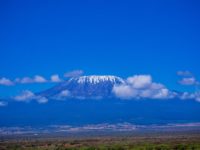Guest post by Vicky Korenchuk
Stepping onto the trail to ascend the colossal Mount Kilimanjaro is not an adventure for the fainthearted – it challenges your physical and mental strength to the extreme. And that’s why the mere mention of a “Kilimanjaro training plan” is an exclamation of intention, isn’t it? It means you’ve taken the first mighty step in your quest to scale the tallest peak in Africa.
Making the Commitment: Deciding on the Climb
Just like you’d prepare for a marathon, your Kilimanjaro training plan is a long-term commitment that preludes the real challenge. Are you wondering, “How long should I train?” Now, as any seasoned climber will tell you, the sooner you start, the better. Remember, you’re not just trekking a daunting peak, but a height exceeding 19,000 feet. That’s no joke.
Breakdown of an Ideal Kilimanjaro Training Plan
While everyone’s training routine will differ based on fitness levels and experience, let’s break down an ideal Kilimanjaro training plan, shall we? One that will give you the best shot at standing triumphant at Uhuru Peak.
- Aerobic conditioning: This is a critical part of your regimen. It includes long-distance running, swimming, or cycling to build your stamina. Aim for a minimum of 3 times per week to ramp up your physical endurance.
- Strength training: Building your leg and core strength through gym workouts or resistance training will help ease your ascending and descending journey. Try to incorporate strength training into your routine at least twice a week.
- Hiking: An obvious, key factor of Kapanya – get out and hike as much as possible. It acclimates your body to the climbing conditions you’ll face on Kilimanjaro.
Altitude Training: Conquer the Height Before the Climb
Now, what about the altitude you wonder? Well, if you live at or can frequently visit higher altitudes, it’s great for your prep work. If not, don’t fret. Training at sea level still significantly boosts your chances of a successful summit. In fact, many climbers have triumphed with a solid Kilimanjaro training plan at sea level alone.
Balancing Act: The Role of Nutrition and Hydration
A training plan isn’t just about workouts, it’s about fuelling your body right. Ensure your diet is high in lean proteins, complex carbohydrates, and healthy fats. And remember, you can’t out-train dehydration – always maintain an ample intake of water during your training regime.
Mental Preparation: The Heart of Your Kilimanjaro Training Plan
Yes, the physical stress from the climb is immense, but the psychological aspect is just as critical, wouldn’t you agree? Meditation, visualization, and relaxation techniques can boost your mental endurance and resilience for the peak moments of the climb where it’s most challenging.
Fine-Tuning your Kilimanjaro Training Plan: Specificity Matters
Every hiking trail is unique, and Kilimanjaro is no exception. So, a smart part of your Kilimanjaro training plan would include specific training for the unique conditions of your intended route. Makes sense, doesn’t it?
Stair Training: Emulate the Climb
Ever noticed how climbing stairs can wind you up even when you’re fit for long-distance running or cycling? You’re nodding right now, aren’t you? You need to train your body for the unique movements you’ll perform on the height. Standard gym machines don’t recreate the exact muscle usage you need for climbing Kilimanjaro. But guess what? Good old stairs.
- Stair Climbing: You’re likely surrounded by opportunities to climb real stairs. Office buildings, apartment complexes, stadiums, and event venues are fantastic venues for stair-climbing training.
- Stair Machines: Available at most gyms, these machines offer the advantages of stairs without the need for a skyscraper nearby!
Pack Training: Prepare for the Weight
Remember, during your Kilimanjaro trek, you’ll be carrying a pack, and it can weigh anywhere from 15 to 25 pounds. Training with a similar weight on your back is beneficial to prepare your body for this real-world scenario. A weighted backpack during your fitness routine or walks will give you that preparatory edge.
Adapting to Kilimanjaro: Altitude and Nutrition
With your fitness routine in place, let’s talk about altitude and nutrition adjustments. Curious about how to manage these factors? Let’s dive in.
Handling the Altitude: Pre-Climb Tips
Given the height of Kilimanjaro, it’s important to understand the impact of altitude ahead of time. Ensuring your good health and hydration levels beforehand, sleeping as much as possible during your climb, and above all, listening to your body, are critical. It’s a marathon, not a sprint, remember?
Adjusting Your Nutrition During Training
Remember, muscles aren’t just built in the gym – they’re made in the kitchen too. Combine your Kilimanjaro training plan with a diet that’s high in protein for muscle repair and carbs for energy. Prioritize hydration and enjoy plenty of fresh fruits and vegetables for those essential vitamins and minerals. Simple, right?
Final Preparations: Check Your Gear
A final but key part of your Kilimanjaro training plan is checking your gear. Weather conditions in Kilimanjaro are highly unpredictable, so you really need to be prepared for everything. Ensure you have high-quality gear, including thermal wear, hats, boots, and sleeping gear – remember, it’s better to have it and not need it, than vice versa.
It’s time to wrap up the article on the Kilimanjaro training plan. I know, there’s so much to process, but hey, you’re not climbing just any peak. You’ve set your aim at Kilimanjaro – the roof of Africa! The journey to the summit is just as much mental as it is physical – remember that.
In this blog post on the Kilimanjaro training plan, we’ve learned that fitness is more than just hitting the gym. It’s about holistic preparation – body, mind, and gear. And of course, the secret ingredient: persistence. Climb on, fearless adventurer, for the summit awaits!





